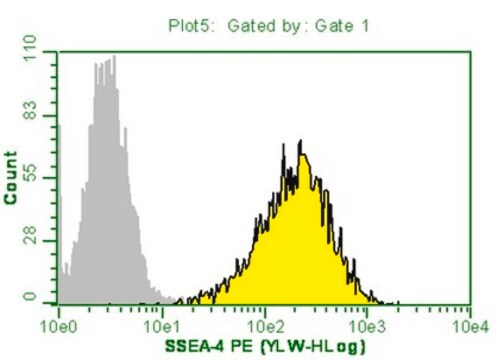FCMAB115F
Anti-TRA-1-60 Antibody, clone TRA-1-60, FITC conjugate
clone TRA-1-60, from mouse, FITC conjugate
About This Item
Polecane produkty
pochodzenie biologiczne
mouse
Poziom jakości
białko sprzężone
FITC conjugate
forma przeciwciała
purified antibody
rodzaj przeciwciała
primary antibodies
klon
TRA-1-60, monoclonal
reaktywność gatunkowa (przewidywana na podstawie homologii)
human (based on 100% sequence homology)
metody
flow cytometry: suitable
immunocytochemistry: suitable
izotyp
IgM
Warunki transportu
wet ice
docelowa modyfikacja potranslacyjna
unmodified
informacje o genach
human ... PODXL(5420)
Opis ogólny
Specyficzność
No immunoreactivity is seen with murine EC, EG, or ES cells. Both the TRA-1-60 and TRA-1-81 monoclonal antibodies (MAB4381) recognize antigens that are associated with a pericellular matrix proteoglycan. TRA-1-60 reacts with a sialidase-sensitive epitope whilst TRA-1-81 reacts with an unknown epitope of the same molecule
Immunogen
Zastosowanie
Immunocytochemical staining of live H9 human ES cells incubated for 30 minutes at 37C with 1:100 dilution of anti-TRA-1-60 FITC conjugated (Cat. No. FCMAB115F) monoclonal antibody. Pluripotent human ES cells exhibit strong immunoreactivity to this antibody.
Flow Cytometry:
Antibody dilution for cellular staining:
- Prepare an antibody working solution by diluting 1:5 the primary antibody with PBS.
- Dispense the volume per test of working of solution according to the number of cells indicated in the table below.
- 5 L for Guava Flow Cytometer
- 10 L for other Flow Cytometry instruments
5 μl Working Solution: 5 x 105 Cells / 95 μl PBS. 100 μl Total Reaction Volume
10 μl Working Solution: 1 x 106 Cells / 90 μl PBS. 100 μl Total Reaction Volume
Stem Cell Research
Pluripotent & Early Differentiation
Opis wartości docelowych
Postać fizyczna
Przechowywanie i stabilność
Komentarz do analizy
Pluripotent human embryonic stem (ES) cells
Oświadczenie o zrzeczeniu się odpowiedzialności
Nie możesz znaleźć właściwego produktu?
Wypróbuj nasz Narzędzie selektora produktów.
Kod klasy składowania
10 - Combustible liquids
Klasa zagrożenia wodnego (WGK)
WGK 2
Temperatura zapłonu (°F)
Not applicable
Temperatura zapłonu (°C)
Not applicable
Certyfikaty analizy (CoA)
Poszukaj Certyfikaty analizy (CoA), wpisując numer partii/serii produktów. Numery serii i partii można znaleźć na etykiecie produktu po słowach „seria” lub „partia”.
Masz już ten produkt?
Dokumenty związane z niedawno zakupionymi produktami zostały zamieszczone w Bibliotece dokumentów.
Nasz zespół naukowców ma doświadczenie we wszystkich obszarach badań, w tym w naukach przyrodniczych, materiałoznawstwie, syntezie chemicznej, chromatografii, analityce i wielu innych dziedzinach.
Skontaktuj się z zespołem ds. pomocy technicznej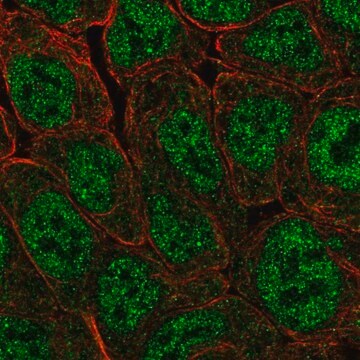
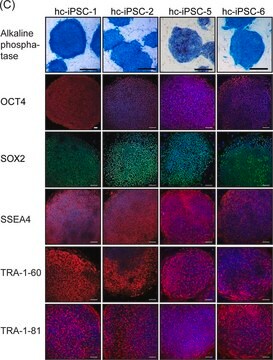
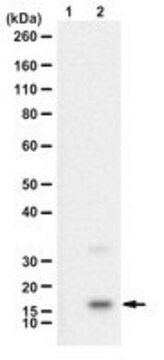
![Anti-OCT-4 [POU5F1] Antibody, clone 7F9.2, Alexa Fluor™ 488 conjugate clone 7F9.2, from mouse, ALEXA FLUOR™ 488](/deepweb/assets/sigmaaldrich/product/images/405/633/324511fc-ecc5-4c49-9d9d-8cf25ab28d40/640/324511fc-ecc5-4c49-9d9d-8cf25ab28d40.jpg)
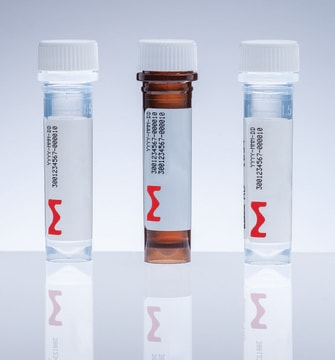
![Anti-OCT-4 [POU5F1] Antibody, clone 7F9.2 clone 7F9.2, from mouse](/deepweb/assets/sigmaaldrich/product/images/307/874/7354f72d-80ee-40a5-b7fa-0590fe6784cc/640/7354f72d-80ee-40a5-b7fa-0590fe6784cc.jpg)
